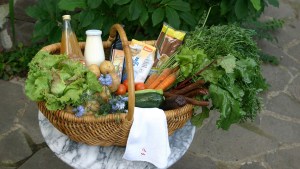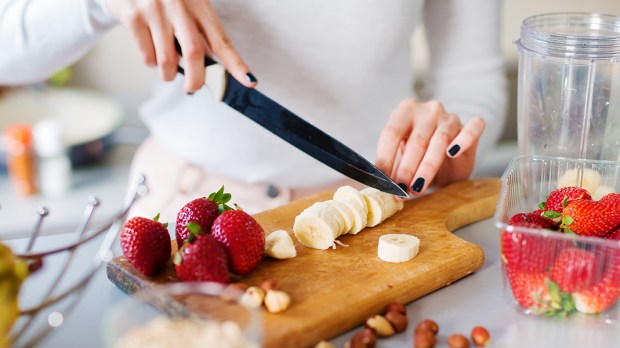In our house, it’s usually strawberries. We love their sweet succulence, especially in smoothies or yogurt. If we don’t get to them quickly, though, they’re consumed by mold and inevitably wind up in the trash. It happens with plenty of other foods besides berries, like peaches and cucumbers.
I never thought much of it until I was struck by a verse in John 6, after the multiplication of the loaves and fish. Once the crowd is satiated, Jesus tells his disciples, “Gather the fragments left over, so that nothing will be wasted.”Allowing food to go to waste is something we’re supposed to consciously avoid.
Not surprisingly, my family isn’t unique in the fact that the food we tend to waste most is fresh produce. Fox News recently reported on a new study of food waste in America that found fruits, vegetables and mixed fruit and vegetable dishes were the type of food thrown away most. As a whole, the study discovered that individuals with healthy diets waste the most food. “Americans waste nearly a pound of food per person each day, and those with higher quality diets are the worst offenders.”
But, of course, healthy eaters shouldn’t decrease fruit and veggie consumption in the name of waste avoidance. A better answer is to adopt better habits that prolong the life of produce and ensure that it gets consumed before going bad.
Here are four simple ways to go about it that work pretty well in our household:
Make it easy to eat
Cornell University once reported on a fascinating study about the effect of sliced versus whole apples in school cafeterias. Evidently, “apple sales in elementary schools jumped by an average of 61 percent when the fruit was sliced.” Professor Brian Wansink, lead author of the study and co-director of the Cornell Center for Behavioral Economics in Child Nutrition Programs, explained, “Slicing fruit works so well because children love to eat fruit in ready-to-eat, bite-sized pieces.”
It’s the same for adults. We’re more likely to ignore produce and reach for chips or a granola bar when we’re too short on time or patience to do the washing, cutting or other prep work required. So when I manage to seize a small chunk of time to rinse, peel, slice, and set aside things like berries and peppers, they’re a lot less likely to end up in the garbage.
Keep veggies fresh longer
We all know leafy greens, like fresh spinach and kale, are tremendously nutritious. But once they get slimy, yuck, and unfortunately it doesn’t take very long for that to happen. A dependable way to prolong their crispiness is to stick a paper towel in the container with them to absorb the moisture that accelerates the wilting process.
In fact, thekitchn.com conducted an experiment with three moisture-absorbing methods to find out which was most effective. “Storing the greens in a container with paper towels was definitely the winner here,” Food Editor Christine Gallary wrote. “Being able to store tender greens for up to ten days is really convenient and will allow me to buy bigger amounts, saving me both time and money since larger bags are usually a better value.”
Personally, I’ve purchased baby spinach and kale and had it remain significantly fresh for weeks beyond the expiration date, thanks to this trick.
The freezer is a friend of preservation
Buying frozen produce is one way to ensure prolonged edibility, but I frequently take fruit or veggies that I get fresh and stick them in the freezer if I foresee them going bad. Really ripe bananas, for example, can be peeled, frozen and then used for a bunch of various flavored smoothies or even super healthy ice cream.
For delicate fruits, like raspberries, you can avoid having them squish together by freezing them in a single layer on a baking sheet and then transferring them to a bag or container once they’re hard and frozen. Frozen grapes also make for a refreshing, wholesome snack during hot weather months.
As for thawing, allrecipes.com explains, “Most vegetables can go directly from freezer to boiling water … Fruits are best when allowed to thaw at room temperature. Delicate berries can turn mushy when thawed completely, so consider eating them before they’re thoroughly thawed, such as in smoothies or as a topping for ice cream or yogurt.”
Proper storage makes all the difference
When it comes to how various fruits and veggies should be stored, you might be surprised to learn that different types of produce do better outside the fridge, and it’s not just potatoes and onions. Readers Digest lists whole melons, fresh herbs, and tomatoes as a few foods that prefer room temperature.
Upon purchasing produce you might not eat right away, it can’t hurt to find out the most optimal means of storing it. Real Simple offers a super handy, alphabetized list of how to help different fruits and vegetables last longest.
In American households, particularly those with little ones whose appetites are impossible to predict, uneaten or unfinished food is inevitable. But it’s the small steps toward preservation that can decrease waste and, hopefully, save us some money on groceries in the process. And don’t forget that once veggies have wilted just a bit too much, they’re still perfect to use for making stocks.
And if all that fails … there’s always composting, a conscious way to return the blessings God gave us back into the cycle of life. There are a variety of ways to do this, big or small, with special containers or not, depending on where you live, but like this method from thekitchn.com it can also be ridiculously simple, and even the kids can do it.

Read more:
10 Foods you should never keep in the fridge

